
Nemophila is a genus found in the flowering plant family Boraginaceae.

Nemophila menziesii, known commonly as baby blue eyes or baby's-blue-eyes, is an annual herb, native to western North America.

Nemophila maculata, commonly known as fivespot, is a species of flowering plant in the borage family (Boraginaceae).
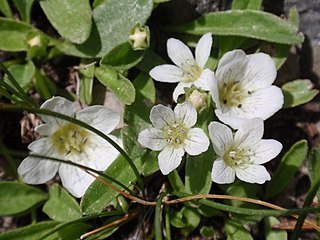
Nemophila spatulata, with the common names Sierra baby blue-eyes and Sierra nemophila, is a dicot in the family Boraginaceae.
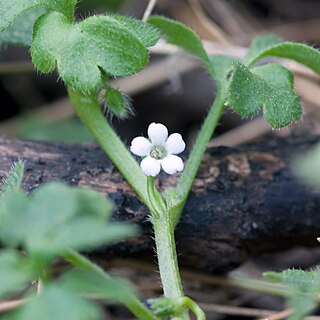
Nemophila aphylla, the smallflower baby blue eyes, is an annual flowering plant in the family Boraginaceae. It is endemic to the southeastern United States and typically found in rich, moist woodlands. It has very small white or pale blue flowers, typically about 0.12 inches wide, that bloom from March to May.

Allium obtusum is a species of wild onion known by the common name red Sierra onion or subalpine onion. It is native to eastern California and western Nevada. It is a common plant in the granite foothills and mountains of the Sierra Nevada and southern Cascade Range, from Tulare County to Siskiyou County, from elevations of 800 to 3,500 metres. In Nevada, it is reported only from Washoe County in the northwestern part of the state.

Triteleia lilacina, the foothill triteleia, is a monocot flowering plant in the genus Triteleia.
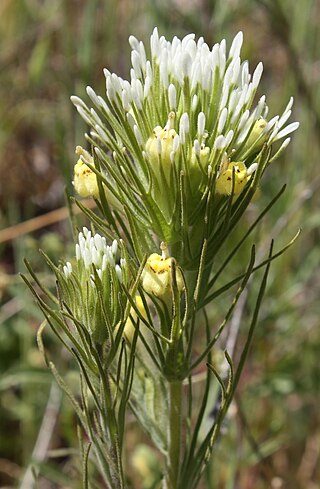
Castilleja lineariiloba is a species of Indian paintbrush known by the common name sagebrush Indian paintbrush that is endemic to the grasslands of the Sierra Nevada foothills in California.

Ceanothus roderickii is a rare species of shrub in the family Rhamnaceae known by the common name Pine Hill ceanothus. It is endemic to western El Dorado County, California, where it grows in the chaparral and woodlands of the Sierra Nevada foothills, such as the Pine Hill Ecological Reserve. It is named after 20th century California flora explorer, botanist, and arboretum director Wayne Roderick.
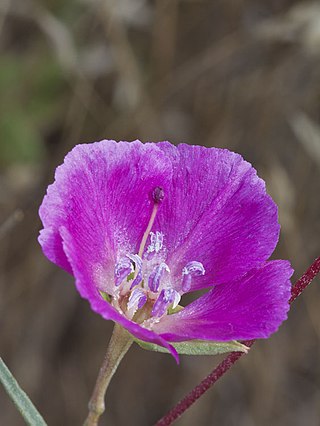
Clarkia speciosa is a species of flowering plant in the evening primrose family known by the common name redspot clarkia. It is endemic to California, where it is known from the Central Coast and mountains and from the Sierra Nevada foothills. The plant is variable across its intergrading subspecies, taking a decumbent to erect form with a stem up to about half a meter long. The open or dense inflorescence has opening flowers and several closed buds. As the bud opens the sepals all separate from each other. The fan-shaped petals are up to 2.5 centimeters long and may be lavender to pink to deep red, sometimes fading to white or yellowish at the base. There is sometimes, but not always, a large bright red spot near the middle of the petal.

Eriogonum kennedyi is a species of wild buckwheat known by the common name Kennedy's buckwheat.

Lomatium caruifolium, known by the common name alkali desertparsley, is a species of flowering plant in the carrot family.
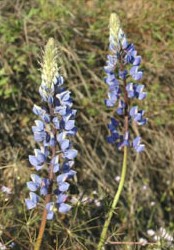
Lupinus benthamii is a species of lupine known by the common name spider lupine.

Lupinus spectabilis is a species of lupine known by the common name shaggyhair lupine. It is endemic to a section of the central Sierra Nevada foothills in Mariposa and Tuolumne Counties, where it is a member of the serpentine soils flora.
Nemophila breviflora is a species of flowering plant in the borage family known by the common names basin nemophila, Great Basin nemophila, and Great Basin baby-blue-eyes. It is native to southwestern Canada and the northwestern United States, where it generally grows in wooded and forested areas in thickets and moist streambanks.

Nemophila heterophylla is a species of flowering plant in the borage family known by the common name small baby blue eyes.

Penstemon heterophyllus is a species of penstemon known by the common names bunchleaf penstemon, foothill penstemon, and foothill beardtongue. It is endemic to California.
Frasera tubulosa is a species of flowering plant in the gentian family known by the common name Kern frasera.

Ericameria parryi is a species of flowering plant in the family Asteraceae known by the common name Parry's rabbitbrush. It is native to much of the western United States.
This page is based on this
Wikipedia article Text is available under the
CC BY-SA 4.0 license; additional terms may apply.
Images, videos and audio are available under their respective licenses.
















